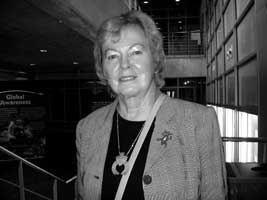| 
Children
Build a Culture of Peace in a Complex World
by
Michelle Accorso
In
John Lennon’s Give Peace a Chance, there were some very
distinct sounding voices singing along with him as he pleaded
with the world to listen to what he was saying. They weren’t
famous recording stars, they weren’t even famous…they were
just children. The message was simple— “All we are saying is
give peace a chance.” Today the message is still simple. However,
conveying a simple plan to people is not always easy.
The
Soka Gakkai International (SGI) Peace Forum Building a Culture
of Peace for the Children of the World held recently at Columbia
University was once again a refrain that sometimes children
have a better grasp on what’s going on than we do. Amidst posters
from all over the world portraying people’s lives and hardships
during violent times, were children’s personal drawings and
paintings describing what peace meant for them.
“I
was very touched and moved by the children’s art exhibit in
general. I paid particular attention to the children’s art,
as I never have before. I perceived within the lives of these
young children, that were expressing themselves through their
art, a very strong desire for peace. This is actually, I think,
the building block or foundation for a peaceful world in the
future,” said Tony Kolens, New York City artist and member
of SGI. “I think the exhibit itself is really about the reality
that in order to build a peaceful world, we have to begin with
the children. We must instill or nurture the desire for peace
among the children.”
That
nurturing must, of course, start with the adults and the most
effective way to accomplish this task is by starting in the
classroom. “When it comes to truly implementing the concept
of non-violence, non-aggression and a peaceful means of resolving
problems, the honest answer to that is we haven’t figured it
out”, said Nel Noddings, Lee L. Jacks Professor of Education
at Stanford University and author of The Challenge to Care
in Schools. “There are many fine programs about non-violence,
but most of them are taught at the elementary and middle-school
level, so we are trying to start to incorporate these programs
more in high schools.” Noddings believes it is the emphasis
so strongly placed on standardized testing and academics that
cause high schoolers to lack the knowledge needed to build
a peaceful foundation for the future. “I think every course
should incorporate teaching peace. Before I did my graduate
work in philosophy I was a math teacher and if it can be done
in math, it can be done anywhere. You have to put a high priority
on it.” The Challenge to Care in Schools is just one
book Noddings suggests as an aid for busy teachers who are
interested in shaping young impressionable students into sensitive,
open-minded adults.
 “There
has to be a concerted effort in teacher training and collaboration
in school systems. We have to begin asking and advocating the
revived aims act,” said Noddings. “What is the aim of education?
Some people just suppose that the aim is to get by with the
best possible marks, get into the best possible college to
get the best possible job to make the most possible money and
buy lots of stuff…and there has to be more to it than that.” “There
has to be a concerted effort in teacher training and collaboration
in school systems. We have to begin asking and advocating the
revived aims act,” said Noddings. “What is the aim of education?
Some people just suppose that the aim is to get by with the
best possible marks, get into the best possible college to
get the best possible job to make the most possible money and
buy lots of stuff…and there has to be more to it than that.”
There
absolutely is more to it than that. As the exhibit pointed
out, “Everything that is needed to build a culture of peace
already exists in each of our hearts.” Some of these barriers
and roots of the problem as to why we don’t currently have
peace include nuclear negativity, the illusion of ‘efficiency,’ prejudice
and stereotyping, environmental irresponsibility, poverty,
isolationism and greed.
Dean
Lawrence Edward Carter of the Martin Luther King, Jr. International
Chapel of Morehouse College in Atlanta, Georgia said, “Perhaps
the reason why the Soka Gakkai International, the leading spiritual
peace community on the planet, is not well-known is because
they don’t preach, they practice.”
“The
government cannot give us peace,” he said, “Peace begins within.
It is up to each of us as individuals to affect the scales
of good versus evil. Your next act, decision and choice is
the only way to tip the scale toward a lasting and just peace.” Paraphrasing
one of the quotes in the exhibit Carter said, “Since wars begin
in the minds of human beings, it is in the minds of humans
that the defenses of peace must be constructed.”
If
only we could hold on tighter to that inner-child in all of
us, we wouldn’t have to worry about creating wars.
“Consciousness
is all-important,” said Carter. “Our unveiling of the Culture
of Peace exhibit is the best anniversary we can inaugurate
for the mental skies of the children of the world in this global
season of terror and war.”#

Education
Update, Inc., P.O. Box 1588, New York, NY 10159.
Tel: (212) 477-5600. Fax: (212) 477-5893. Email: ednews1@aol.com.
All material is copyrighted and may not be printed without express consent of
the publisher. © 2003.
|
